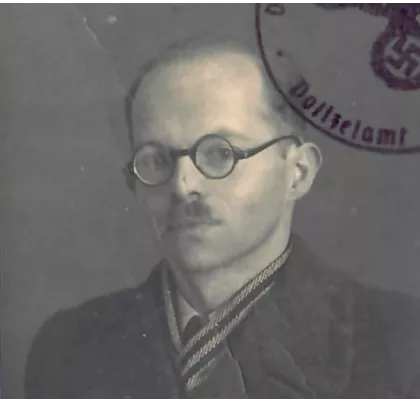Erich Lichtblau / after 1945 Eli Leskly (1911-2004)
Drawing to survive
Erich Lichtblau drew numerous pictures and caricatures in the Theresienstadt ghetto. In his caricatures, he captured the situations and hardships of everyday life in the ghetto through an ironic lens. The so-called "artist affair" highlights the enormous associated dangers of his hobby: in the summer of 1944, pictures by the well-known artists Leo Haas, Ferdinand Bloch, Otto Ungar and Bedřich Fritta that accurately depicted the terrible everyday life in the ghetto were found. As a result, the artists were deported to the Gestapo prison "Small Fortress" and from there to the extermination camps. Only Leo Haas survived. Erich wanted to destroy all the painting when his artist friends disappeared but Else did not allow him saying ”If we survive, nobody will believe what we went through. The paintings are our only evidence”. Together they cut all captions and other “discriminating” parts out of the paintings and the rest Else wrapped and threw through a crack in the wooden floor boards in her barrack. Shortly afterwards, Erich was sent to Wulkow. When they were liberated they found and saved the package from under the floor and took it to Prague with them, where Leskly reconstructed the cuttings like puzzle with the missing parts left empty, all on black cardboard album pages he created. Erich kept painting many versions of each of his original Terezin painting most of his life.
Erich was born into a middle-class family on 16 June 1911 in the small Moravian town of Hrušov, today a district of Ostrava. His father, a tailor, died when Erich was only nine years old and left Erich's mother with four children. Erich was forced to leave school and help earn money as an electrician apprentice. He moved in with his grandfather Samuel Storch, who was a travelling salesman and a respected member of the Jewish community. In his free time, he made art carvings that always fascinated Erich. He trained as a decorator.
Erich was active in the Jewish youth movement and planned to emigrate to Palestine several times, but did not have "the strength or the means".
In 1930, he started studying product design at the Hamburg Decorating College. After graduation, he returned to Ostrava and worked as a decorator. On 30 May 1937 he married Elsa (Else) Silbiger, born on 26 July 1913.
Soon after the occupation of Czechoslovakia in March 1939, the couple fled to Prague, where Erich worked as a construction worker. At the beginning of 1940, Erich and Elsa moved to the small village of Dobešice near Písek in southern Bohemia to "go on Hakhshara" with a Zionist youth group. They learnt Hebrew and gained practical knowledge that would be useful for their emigration to Palestine. The only photo of the couple from the time before they were imprisoned in the Theresienstadt ghetto is from this period.
After the Hakhshara was dissolved, they worked in forced labour before finally being deported to the Theresienstadt ghetto in November 1942. There, Erich was assigned to the building yard and Elsa worked as a cleaner in the children's home and in the kitchens. Sometime later, Erich was transferred to the Graphics and Reproduction Department, a subdivision of the Technical Department. Among other things, he worked on the design of the ghetto theatres there. The network of the Zionist youth organisation and its umbrella association Hechaluz continued to exist in the ghetto.
On 26 August 1944, Erich Lichtblau arrived on what was probably the last transport to Wulkow, where he worked as a painter. Else remained in the ghetto and was protected from deportation thanks to Erich's work in Wulkow. She hid his drawings, saving them for posterity. In Wulkow, Erich expressed Stuschka's sadism in drawings: he captured the degrading punishment of his fellow prisoner Ludwig Breier. He was forced into a kind of bird cage in front of his fellow prisoners. In another picture, he drew his friends in the Wulkow camp. In February 1945, Erich returned to the ghetto after an inhumane eight-day train journey.
- © Privat
- © Privat
Soon after liberation, he changed his name to Eli Leskly. Elsa refused to carry a German name after the war. One day she was asked by a sales person for her name to put on a receipt. When she replied “Else Lichtblau”, he said to her “Sie sind Deutsch? [You are German?]” Elsa when home said to Erich, “They murdered our families, I refuse to be mistaken for German”.
Eli also began to restore the drawings kept by Elsa and made new drawings about his time in prison. In 1946 Eli and Elsa's daughter Mira was born. Two years later, their son Rani was born. They initially lived in Písek, very close to their former Hakhshara training centre, and later moved to Teplice, in the former Sudeten territories. In 1949, the family emigrated to Israel via Italy.
There, Eli continued his restoration work and, after retiring in the 1970s, redrew many of his pictures in a larger poster size. His first exhibition took place in 1976 at the Beit Terezín memorial, founded by ghetto survivors, and in 1984, after Leskly had lent most of his drawings to the Holocaust Museum in Los Angeles, he had his first exhibition in the USA.
In Israel, Eli initially earned his living by painting facades. From 1957 until his retirement 20 years later, he worked as a window decorator in a Tel Aviv department store. He died in 2004 at the age of 93. Elsa died in 2010 at the age of 97. It was only this year that their daughter Mira-Oren Leskly found out about her father's imprisonment in Wulkow.
- © The Hebrew University of Jerusalem

